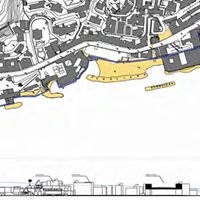The Waterfront of Naples in the New Master Plan
Abstract
The paper suggests a synthetic summary of the main elements involved in the complex process of requalification of Naples coastline, starting from the new general town plan. The requalification of the coastline and the reconstitution of a true relationship of city and sea is one of the crucial actions of the strategy established by the new Master Plan in order to offer an high urban quality to Naples. In the Master Plan the whole coastline, from La Pietra to Pietrarsa, is subjected to the approval of an Executive Plan (Piano Urbanistico Attuativo ) that, for few segments covered by environmental planning, such as Posillipo, is required also by the landscape plan in force, in order to suggest planning and operative solutions to the current safeguarding action. The development of the UIP is still in progress and the Municipal Urban Planning Department has been given the task of it. As it occurred in similar occasions, the operating choice consists in making an implementing planning for sections, placed anyway into a unitary basic design and formal framework which define the fundamental strategy and goals. The reconstitution of the relationship between city and sea is pursued in three different ways: a) improvement of the accesses to the sea, which at present are forbidden in several stretches of the coast; b) improvement of the coast infrastructure, on different levels, from swimming to harbour ones; c) realization of a coast infrastructure and equipment system articulated and distributed in different ways: infrastructure specifically targeted to improve the mobility along the coast, characterized by high congestion of the metropolitan area; equipment specifically targeted to facilitate the use of the coast as unique, extraordinary infrastructure for free time, amusements and enjoyment of natural resources. All those modalities should be accomplished in accordance with the safeguard and exploitation of the many historic and environmental resources characterizing the Neapolitan coast. It should be mentioned too that the general town plan states that the coast equipment – starting from the landing places for recreational boating - should not be sized according to the need it expresses, but on the effective availability that the city territory can really offer, taking into account the safeguard of the prevailing requirements of historical, natural and environmental resources. Besides the general town plan hopes that the action on the city coast could be connected, on both sides, with similar initiatives outside the municipal borders. Five years after the approval of the new general town plan, the implementation of the carried out choices shows a combination of implementation planning initiatives and effective realizations that – although with difficulty – begin delineating a new scenario.Downloads

Copyright (c) 2014 Tema. Journal of Land Use, Mobility and Environment

This work is licensed under a Creative Commons Attribution 4.0 International License.
Authors who publish in this journal agree to the following:
1. Authors retain the rights to their work and give in to the journal the right of first publication of the work simultaneously licensed under a Creative Commons License - Attribution that allows others to share the work indicating the authorship and the initial publication in this journal.
2. Authors can adhere to other agreements of non-exclusive license for the distribution of the published version of the work (ex. To deposit it in an institutional repository or to publish it in a monography), provided to indicate that the document was first published in this journal.
3. Authors can distribute their work online (ex. In institutional repositories or in their website) prior to and during the submission process, as it can lead to productive exchanges and it can increase the quotations of the published work (See The Effect of Open Access)
